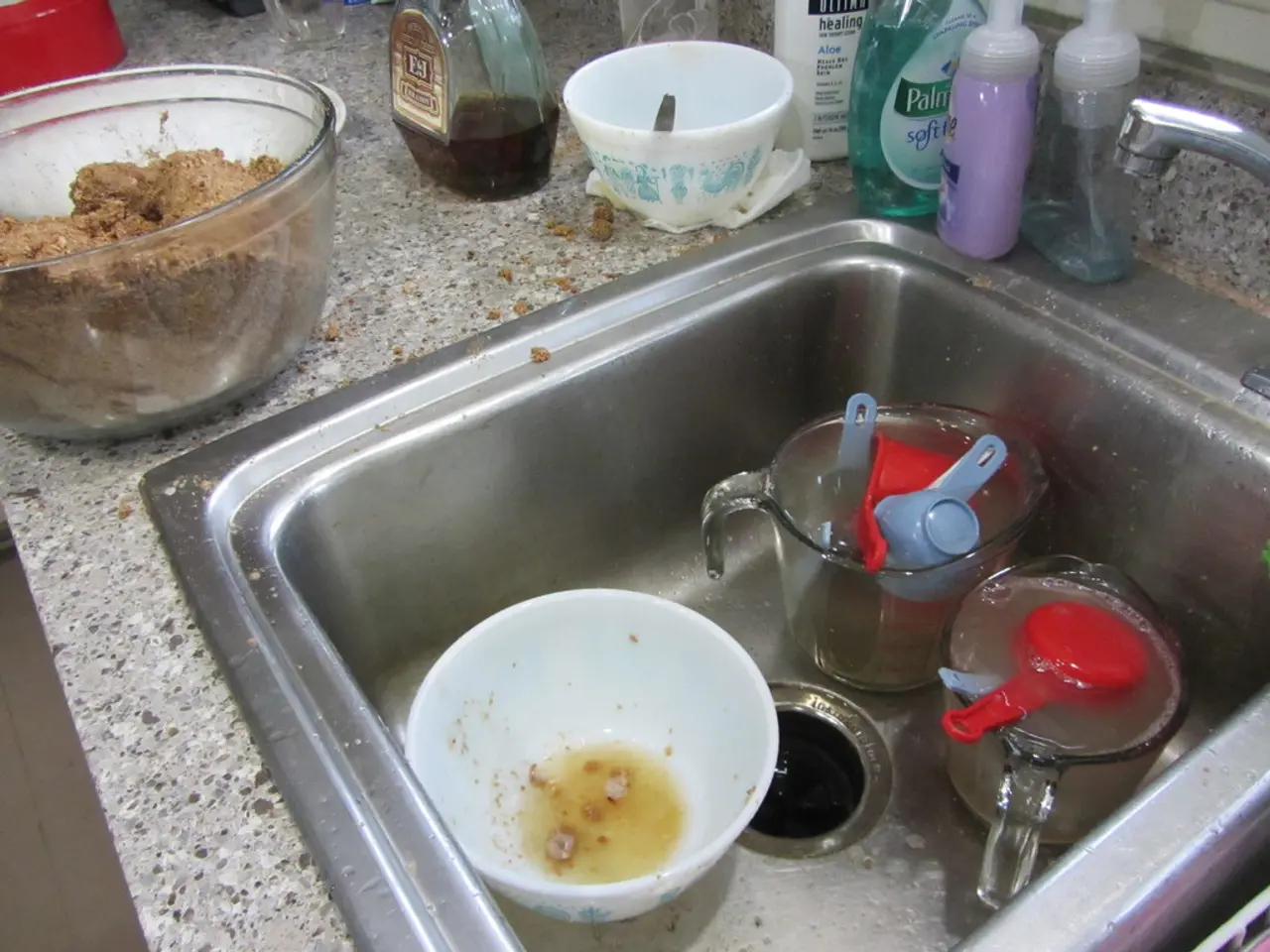Alleviating Gallbladder Discomfort: Suggested Medical Strategies and Home Solutions
**Common Symptoms of Gallbladder Pain: What to Look Out For**
Gallbladder pain can be a distressing and uncomfortable experience, but understanding its common symptoms can help individuals seek prompt medical attention when necessary. Here are some of the key signs to watch out for:
1. **Severe abdominal pain**: This pain is typically located in the upper right abdomen and may occur after eating, particularly if the meal is large or high in fat. The pain may radiate to the back or right shoulder blade.
2. **Nausea and vomiting**: These symptoms, especially after meals, are common in people experiencing gallbladder pain.
3. **Indigestion, bloating, and gas**: These problems, especially after high-fat foods, can occur when the gallbladder cannot release enough bile to digest fats effectively.
4. **Fever or chills**: These symptoms may indicate inflammation (acute cholecystitis) or infection and require immediate medical attention.
5. **Jaundice**: This yellowing of the skin or eyes can occur in more severe cases, signaling a possible bile duct obstruction.
If you experience any of these symptoms, it is crucial to seek immediate medical attention, as complications can develop rapidly.
**Home Remedies for Mild Symptoms**
While home remedies are not a substitute for medical treatment, especially in severe or complicated cases, some approaches may help manage mild symptoms:
- **Lemon juice with warm water**: This popular folk remedy may offer some relief, although there is limited scientific evidence supporting its effectiveness. - **Dietary changes**: Eating a low-fat, low-cholesterol diet can help reduce symptoms and prevent gallstone formation. - **Hydration**: Drinking plenty of water may help prevent gallstones and support digestion. - **Regular exercise** and **weight management** are recommended, as obesity is a risk factor for gallstones. - **Homeopathic remedies** such as Chelidonium, Lycopodium, and Nux vomica are sometimes used, but evidence for their efficacy is limited and consultation with a qualified practitioner is advised.
**Medical Treatment Options**
The appropriate treatment depends on the severity and cause of symptoms:
- **Medications**: Oral bile acids (e.g., ursodeoxycholic acid, chenodiol) may be prescribed to dissolve certain types of gallstones in individuals who cannot undergo surgery. - **Surgery**: **Cholecystectomy** (removal of the gallbladder) is the definitive treatment for recurrent or complicated gallstones. - **Lifestyle management**: For asymptomatic or mild cases, dietary and lifestyle modifications may be sufficient. - **Emergency care**: Acute cholecystitis or bile duct obstruction requires urgent evaluation, possibly including antibiotics, drainage procedures, or surgery.
**When to Seek Medical Help**
If you experience:
- Severe, persistent, or worsening abdominal pain - High fever or chills - Jaundice - Persistent vomiting - Symptoms that interfere with daily life
Prompt medical evaluation is crucial to prevent serious complications such as infection, pancreatitis, or bile duct obstruction.
It is essential to remember that the gallbladder is not necessary for human life, and if a person has severe problems associated with their gallbladder, doctors may find it safer to remove the gallbladder. Losing weight can help reduce the likelihood that gallbladder pain will recur.
If you are experiencing gallbladder pain, it is important to avoid greasy, high-fat foods, including fatty cuts of meat, and spicy foods, as these can worsen the condition. Gallbladder removal surgery, or cholecystectomy, can be performed as a minimally invasive laparoscopic procedure or an open procedure, with the former generally enhancing the person's recovery and outcome.
In some cases, a biliary drainage procedure may be recommended if a person is unlikely to be able to withstand surgery. This procedure involves placing a small stent that allows bile to drain from the liver. Home remedies for gallbladder pain may involve avoiding foods known to worsen the condition, such as high-fat foods and spicy foods.
If you experience symptomatic gallbladder pain, you have a 29% chance of having another episode within a year if you do not undergo gallbladder removal. Cholecystitis, a condition caused by gallbladder inflammation, is a source of gallbladder pain. Apple cider vinegar, castor oil, and other natural laxatives are often claimed to help relieve gallbladder pain, but there is limited medical research supporting their effectiveness.
Cholecystitis pain comes on after a meal or in the evenings, worsens when taking a deep breath, and can be sudden and intense. Gallstones can cause gallbladder swelling, inflammation, and potential infection. The gallbladder is a small digestive organ that stores and releases bile to aid digestion.
- Diabetes, a chronic disease, requires careful management for optimal health.
- HIV is a viral infection that can lead to AIDS, a life-threatening condition if left untreated.
- Asthma, a respiratory condition, can cause difficulty breathing, chest tightness, and coughing.
- Migraines, a type of headache, are often disabling and can last for hours or days.
- PREP (Pre-Exposure Prophychaxis) is a method to prevent HIV transmission for those at high risk.
- Predictive healthcare models aim to anticipate health issues before they become serious.
- Depression, a mental health disorder, can affect daily life and requires treatment.
- Hepatitis, a liver disease, can cause fatigue, nausea, and yellowing of the skin and eyes.
- Digestive issues can range from minor discomfort to severe, chronic conditions like cholecystitis.
- Cholecystitis, a gallbladder inflammation, can cause abdominal pain and require medical attention.
- Sclerosis, a condition characterized by hardening of the tissue, can affect various parts of the body, such as the nervous system.
- Health is a valuable asset that should be protected and maintained.
- Eczema, a skin condition, can cause itchiness, redness, and rashes.
- In the workplace, wellness programs can promote healthy lifestyles and improve employee well-being.
- Multiple medical conditions, such as diabetes and high blood pressure, may require coordinated management.
- Gallstones, hardened deposits in the gallbladder, can cause pain and discomfort.
- AQ, a clean, water-based solution, is used for various purposes in science and industry.
- Science plays a crucial role in understanding and addressing health and environmental issues.
- Workplace wellness initiatives can include fitness and exercise programs, mental health support, and health screenings.
- Medical conditions, including chronic diseases like diabetes and hepatitis, require ongoing management.
- Chronic kidney disease is a serious condition that can become worse over time and lead to kidney failure.
- Type-2 diabetes, a form of diabetes linked to lifestyle factors, is on the rise globally.
- Respiratory conditions, like asthma and COPD, can affect breathing and quality of life.
- Eye health is crucial for overall health, as vision problems can impact daily activities.
- Hearing loss, a common issue in older adults, can be managed with hearing aids and other treatments.
- Health and wellness encompass physical, mental, and social aspects of living.
- Fitness and exercise are essential components of a healthy lifestyle.
- Climate change poses a threat to health, with potential impacts on air and water quality, food security, and Vector-borne diseases.
- In the manufacturing industry, safety protocols and workplace wellness initiatives can prevent accidents and improve worker health.
- Mental health is as important as physical health, with conditions like depression and anxiety affecting millions worldwide.
- Skin care practices, such as regular cleaning, moisturizing, and protection from the sun, can help maintain healthy skin.
- Therapies and treatments for various health conditions, such as psychotherapy and medication, can help manage symptoms and improve quality of life.
- Good nutrition is vital for overall health, with a balanced diet providing essential vitamins and minerals.
- The finance industry plays a role in providing insurance and loans for medical treatments, health care facilities, and wellness initiatives.
- Environmental science helps us understand the impacts of human activities on the environment and the implications for health.
- Lifestyle factors such as diet, exercise, and stress management can impact various chronic diseases, including diabetes, heart disease, and mental health.




